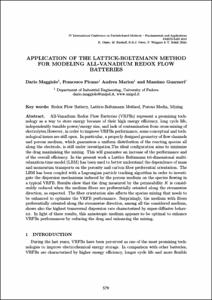Mostra el registre d'ítem simple
Application of the Lattice-Boltzmann method for modeling All-Vanadium Redox Flow Batteries
| dc.contributor.author | Maggiolo, Dario |
| dc.contributor.author | Picano, Francesco |
| dc.contributor.author | Marion, Andrea |
| dc.contributor.author | Guarneri, Massimo |
| dc.date.accessioned | 2020-05-18T16:41:22Z |
| dc.date.available | 2020-05-18T16:41:22Z |
| dc.date.issued | 2015 |
| dc.identifier.isbn | 978-84-944244-7-2 |
| dc.identifier.isbn | Anglès |
| dc.identifier.uri | http://hdl.handle.net/2117/187967 |
| dc.description.abstract | All-Vanadium Redox Flow Batteries (VRFBs) represent a promising technology as a way to store energy because of their high energy efficiency, long cycle life, independently tunable power/energy size, and lack of contamination from cross-mixing of electrolytes.However, in order to improve VRFBs performance, some conceptual and tech- nological issues are still open. In particular, a properly designed geometry of flow channels and porous medium, which guarantees a uniform distribution of the reacting species all along the electrode, is still under investigation.The ideal configuration aims to minimize the drag maximising the mixing. This will guarantee an increase of the performance and of the overall efficiency. In the present work a Lattice Boltzmann tri-dimensional multi- relaxation-time model (LBM) has been used to better understand the dependence of mass and momentum transports on the porosity and carbon fiber preferential orientation. The LBM has been coupled with a Lagrangian particle tracking algorithm in order to investi- gate the dispersion mechanisms induced by the porous medium on the species flowing in a typical VRFB. Results show that the drag measured by the permeability K is considerably reduced when the medium fibers are preferentially oriented along the streamwise direction, as expected. The fiber orientation also affects the species mixing that needs to be enhanced to optimize the VRFB performance. Surprisingly, the medium with fibers preferentially oriented along the streamwise direction, among all the considered medium, shows also the highest transversal dispersion rate characterized by super-diffusive behav- ior. In light of these results, this anisotropic medium appears to be optimal to enhance VRFBs performances by reducing the drag and enhancing the mixing. |
| dc.format.extent | 11 p. |
| dc.language.iso | eng |
| dc.publisher | CIMNE |
| dc.subject.lcsh | Finite element method |
| dc.subject.lcsh | Computational methods in mechanics |
| dc.subject.lcsh | Particle methods (Numerical analysis) |
| dc.subject.other | Redox Flow Battery, Lattice-Boltzmann Method, Porous Media, Mixing |
| dc.title | Application of the Lattice-Boltzmann method for modeling All-Vanadium Redox Flow Batteries |
| dc.type | Conference report |
| dc.subject.lemac | Elements finits, Mètode dels |
| dc.rights.access | Open Access |
| local.citation.contributor | PARTICLES IV |
| local.citation.publicationName | PARTICLES IV : proceedings of the IV International Conference on Particle-Based Methods : fundamentals and applications |
| local.citation.startingPage | 579 |
| local.citation.endingPage | 589 |


